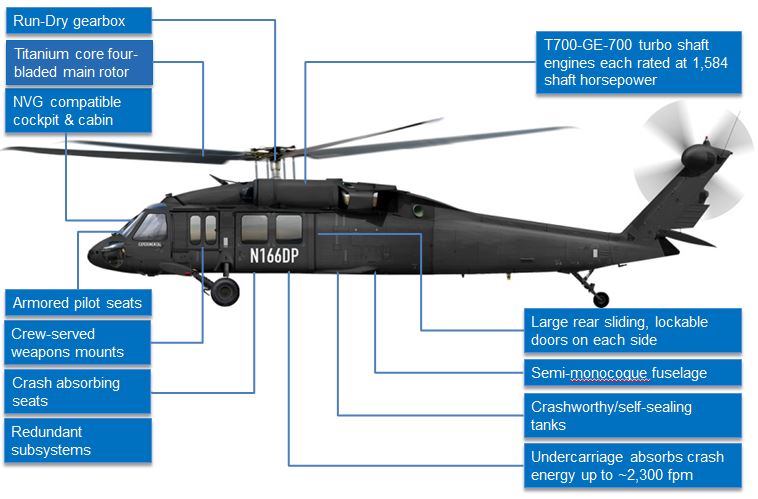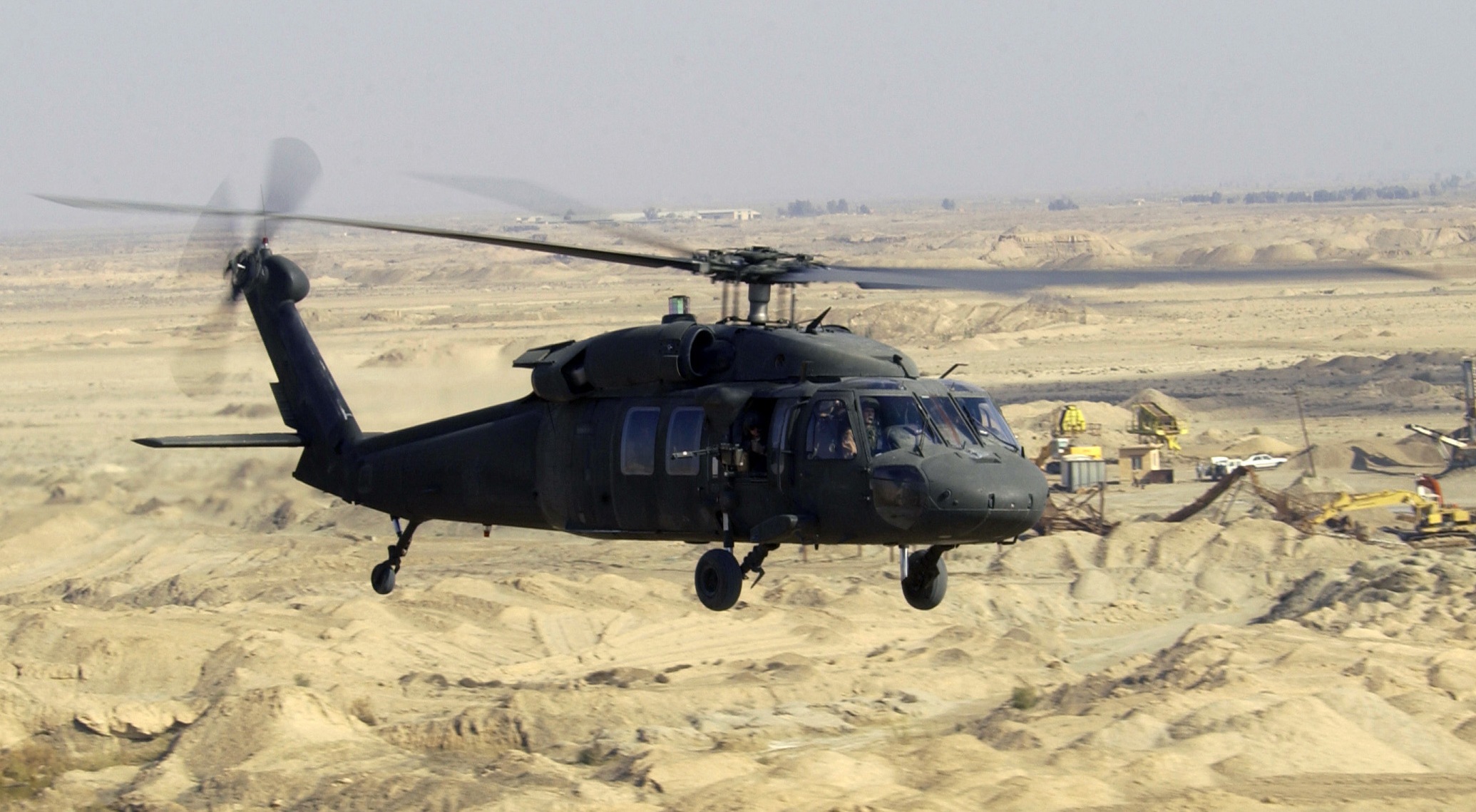Exploring the Flexibility of the UH 60 in Various Army and Civilian Roles
Exploring the Flexibility of the UH 60 in Various Army and Civilian Roles
Blog Article
UH-60: Developments in Modern Helicopter Design
The UH-60 helicopter stands as a standard in contemporary aviation, showcasing considerable innovations in style and innovation that accommodate the developing needs of military operations. Its unification of innovative products not just improves efficiency yet additionally addresses important safety concerns. Furthermore, the assimilation of innovative avionics has actually changed operational capabilities, enabling greater situational awareness and decision-making efficiency. As we discover the development and crucial developments of the UH-60, it comes to be important to take into consideration just how these advancements affect not only current applications however likewise the future landscape of helicopter layout.

Advancement of the UH-60
The advancement of the UH-60 Black Hawk helicopter stands for a significant milestone in aerospace design and armed forces aviation. Introduced in the late 1970s, the UH-60 was made by Sikorsky Airplane to fulfill the United States Army's requirement for a flexible energy helicopter efficient in performing a variety of goals. Its style stressed rate, ability to move, and toughness, establishing brand-new criteria for operational efficiency.
The UH-60 features a distinct four-blade blades system, which improves lift and security, allowing it to operate efficiently in varied environments. Its airframe is created from sophisticated composite products, adding to a decrease in weight while keeping structural integrity. The helicopter's layout also incorporates improved the rules of aerodynamics, which enhances fuel efficiency and boosts array.
Over the years, the Black Hawk has undertaken multiple upgrades to enhance its capacities, consisting of enhanced engines, progressed trip control systems, and modular systems for very easy upkeep and versatility. The helicopter's capacity to execute objectives ranging from troop transportation to clinical discharge has actually solidified its function as a foundation of united state armed forces operations. The UH-60 Black Hawk remains an archetype of how technology in helicopter style can dramatically affect armed forces efficiency and operational adaptability.
Advanced Avionics Systems
Developments in avionics systems have actually transformed the abilities of modern helicopters like the UH-60 Black Hawk, boosting functional effectiveness and situational recognition (UH 60). The assimilation of innovative avionics enables boosted interaction, flight, and navigation management, making the UH-60 extra versatile in diverse objective accounts
Among the essential attributes is the sophisticated digital cabin, which utilizes multifunction display screens that provide real-time information, making sure pilots have instant access to critical trip information. This streamlining of info minimizes pilot workload and improves decision-making procedures throughout complicated procedures. Furthermore, the incorporation of GPS and inertial navigation systems enables exact positioning and route preparation, boosting goal execution in difficult atmospheres.
Furthermore, progressed avionics systems improve interaction capabilities with secure data links and voice interaction systems, enabling smooth control with ground forces and other airplane. The integration of automatic flight control systems even more adds to enhanced stability and control, especially in negative weather conditions or during low-altitude maneuvers.
Engine and Performance Enhancements
Engine efficiency in modern-day helicopters has taken a significant leap ahead, driven by innovations that increase performance, reliability, and power. At the leading edge of these innovations is the adoption of even more effective turboshaft engines, especially those employing innovative products and technologies that make it possible for greater temperature level resistances and increased drive abilities. The UH-60 Black Hawk, as an example, uses the T700-GE-701C engine, which includes a dual-channel, full-authority electronic engine control system. This system enhances performance while maximizing fuel intake and reducing maintenance needs.
Furthermore, the combination of engine health and wellness tracking systems enables real-time diagnostics and predictive upkeep, check my site considerably enhancing functional reliability. These systems not just alert crews to possible concerns before they come to be critical but additionally assist in more effective maintenance scheduling, thus reducing downtime.

Materials and Structural Innovations
Recent growths in materials and structural style have reinvented modern helicopter building, enhancing both performance and toughness. The intro of innovative composite products, such as carbon fiber strengthened polymers, has substantially reduced weight while preserving architectural stability. This change not only improves gas performance yet likewise enhances haul capability, enabling helicopters like the UH-60 to do even more varied goals.
Additionally, innovations in aluminum alloys and titanium elements have actually added to boosted resistance to deterioration and fatigue, extending the life-span of essential airframe elements. The strategic use of these materials has actually brought about a reduction in maintenance demands and improved total functional readiness.

In addition, the combination of computer-aided design (CAD) and additive production technologies has actually made it possible for more light-weight frameworks and complicated geometries, maximizing the wind resistant efficiency of helicopter designs. These improvements facilitate fast prototyping and production, allowing suppliers to respond quickly to evolving goal demands.
Safety and Survivability Functions
Safety and security and survivability features in modern helicopter style have become vital, showing the increasing demands for goal effectiveness in challenging settings. The UH-60 Black this website Hawk, a remarkable example, integrates innovative technologies to enhance staff and guest defense. One of one of the most crucial innovations is the incorporation of crashworthy fuel systems created weblink to reduce the risk of fire throughout influence. In addition, the airframe is constructed with strengthened materials that absorb and dissipate energy, further safeguarding residents in the event of a crash.
The helicopter also employs a ballistic security system, which includes armored crew seats and crucial systems protecting, reducing susceptability to tiny arms fire and shrapnel. Enhanced situational understanding is achieved via sophisticated avionics and sensing unit modern technologies, allowing pilots to discover and avoid hazards successfully.
In addition, the assimilation of redundancy in vital systems-- such as double engines and multiple flight control channels-- makes sure continued procedure also if one system fails. The UH-60 is geared up with innovative emergency situation flotation devices, enhancing survivability in water landings. Collectively, these attributes not just improve the safety of personnel but also increase objective success rates in hostile environments, showing the dedication to quality in helicopter style.
Conclusion
The UH-60 helicopter stands for a significant improvement in contemporary aviation innovation, incorporating cutting-edge products, cutting-edge avionics, and robust safety and security attributes. Its evolution reflects a commitment to enhancing efficiency and operational performance while making sure pilot and crew survivability. The combination of light-weight composites and advanced navigating systems emphasizes the helicopter's versatility in numerous armed forces goals. Overall, the UH-60 functions as a standard for future developments in helicopter design, symbolizing resilience and adaptability in contemporary military procedures.
The UH-60 helicopter stands as a benchmark in contemporary air travel, showcasing substantial improvements in design and technology that provide to the progressing needs of armed forces procedures. As we explore the advancement and key innovations of the UH-60, it becomes crucial to think about just how these developments affect not only present applications yet likewise the future landscape of helicopter style.
Introduced in the late 1970s, the UH-60 was created by Sikorsky Aircraft to fulfill the United States Army's need for a functional utility helicopter capable of performing a variety of goals. The UH-60 Black Hawk stays a prime example of just how technology in helicopter design can considerably influence armed forces effectiveness and functional adaptability.
In general, the UH-60 serves as a standard for future advancements in helicopter layout, personifying durability and adaptability in contemporary army operations.
Report this page